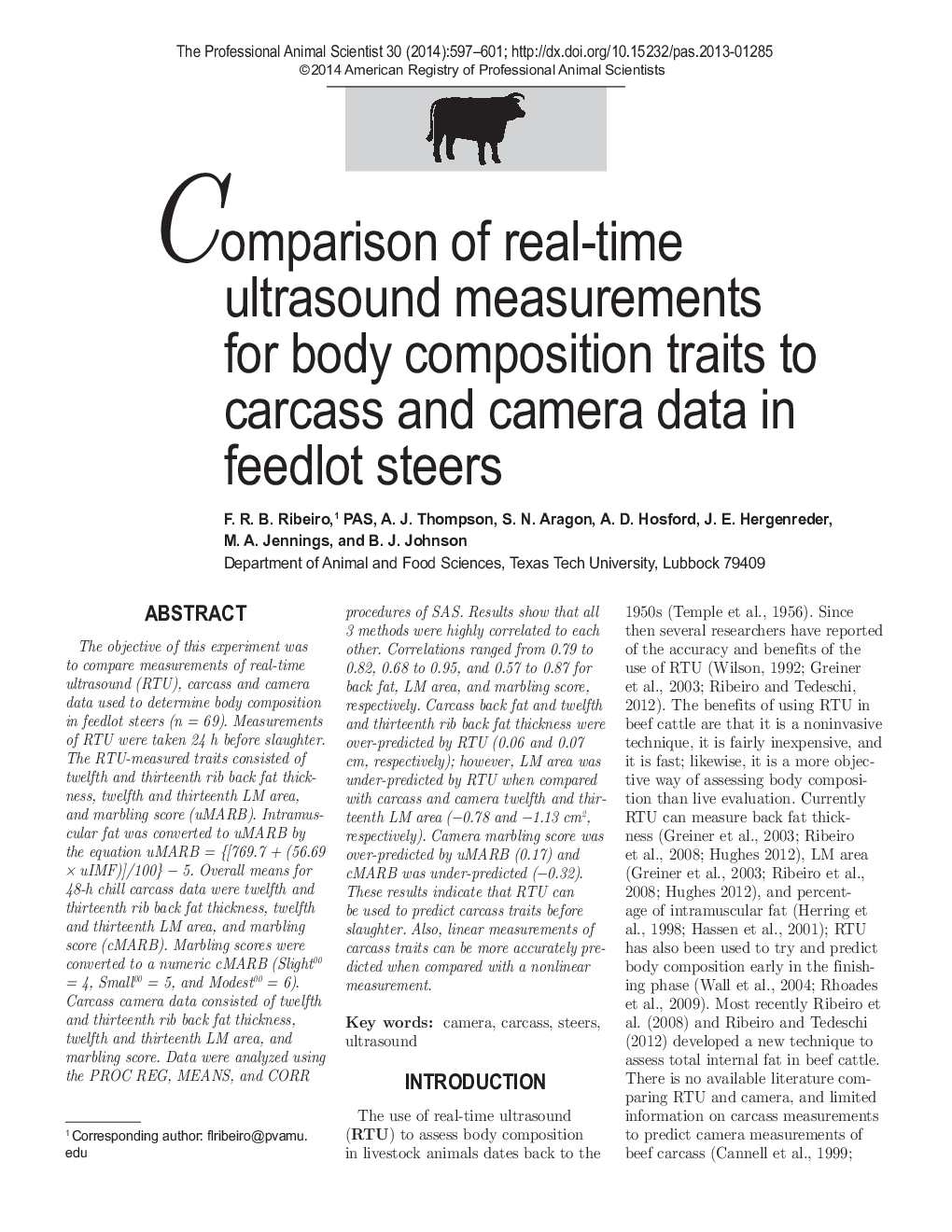| کد مقاله | کد نشریه | سال انتشار | مقاله انگلیسی | نسخه تمام متن |
|---|---|---|---|---|
| 2453805 | 1554288 | 2014 | 5 صفحه PDF | دانلود رایگان |
عنوان انگلیسی مقاله ISI
Comparison of real-time ultrasound measurements for body composition traits to carcass and camera data in feedlot steers
ترجمه فارسی عنوان
مقایسه اندازه گیری های اولتراسوند در زمان واقعی برای صفات ترکیب بدن به لاشه و دوربین داده در گوساله های پرواری
دانلود مقاله + سفارش ترجمه
دانلود مقاله ISI انگلیسی
رایگان برای ایرانیان
کلمات کلیدی
دوربین، لاشه، سرنشینان سونوگرافی،
موضوعات مرتبط
علوم زیستی و بیوفناوری
علوم کشاورزی و بیولوژیک
علوم دامی و جانورشناسی
چکیده انگلیسی
The objective of this experiment was to compare measurements of real-time ultrasound (RTU), carcass and camera data used to determine body composition in feedlot steers (n = 69). Measurements of RTU were taken 24 h before slaughter. The RTU-measured traits consisted of twelfth and thirteenth rib back fat thickness, twelfth and thirteenth LM area, and marbling score (uMARB). Intramuscular fat was converted to uMARB by the equation uMARB = {[769.7 + (56.69 Ã uIMF)]/100} â 5. Overall means for 48-h chill carcass data were twelfth and thirteenth rib back fat thickness, twelfth and thirteenth LM area, and marbling score (cMARB). Marbling scores were converted to a numeric cMARB (Slight00 = 4, Small00 = 5, and Modest00 = 6). Carcass camera data consisted of twelfth and thirteenth rib back fat thickness, twelfth and thirteenth LM area, and marbling score. Data were analyzed using the PROC REG, MEANS, and CORR procedures of SAS. Results show that all 3 methods were highly correlated to each other. Correlations ranged from 0.79 to 0.82, 0.68 to 0.95, and 0.57 to 0.87 for back fat, LM area, and marbling score, respectively. Carcass back fat and twelfth and thirteenth rib back fat thickness were over-predicted by RTU (0.06 and 0.07 cm, respectively); however, LM area was under-predicted by RTU when compared with carcass and camera twelfth and thirteenth LM area (â0.78 and â1.13 cm2, respectively). Camera marbling score was over-predicted by uMARB (0.17) and cMARB was under-predicted (â0.32). These results indicate that RTU can be used to predict carcass traits before slaughter. Also, linear measurements of carcass traits can be more accurately predicted when compared with a nonlinear measurement.
ناشر
Database: Elsevier - ScienceDirect (ساینس دایرکت)
Journal: The Professional Animal Scientist - Volume 30, Issue 6, December 2014, Pages 597-601
Journal: The Professional Animal Scientist - Volume 30, Issue 6, December 2014, Pages 597-601
نویسندگان
F.R.B. PAS, A.J. Thompson, S.N. Aragon, A.D. Hosford, J.E. Hergenreder, M.A. Jennings, B.J. Johnson,
